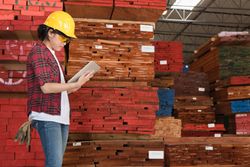What's the Difference Between Nominal and Actual Lumber Sizes?

Lumber serves a variety of purposes and offers a host of benefits, making it a must-have for many projects. As such, when the time comes to start shopping, you want to ensure you get exactly the right product. To do this, though, you need to start by understanding the difference between actual and nominal lumber sizes. The following guide offers an introduction to this topic to help you do just that.
What Is the Difference Between Nominal & Actual Lumber Sizes?
Simply put, nominal and actual sizes refer to the “before” and “after” dimensions of the lumber, respectively. The former refers to the size of the wood after a rough cut, before it has been treated. These treatments may include drying and planing (or smoothing) the wood. The latter refers to the size of the wood after it has undergone the aforementioned treatments.
How Should You Read Descriptions When Assessing These Labels?
 When you visit the lumberyard, it’s important to keep in mind that most product labels feature the nominal size of the wood and not the actual size. As such, you should get used to converting nominal measurements to actual sizes. Most lumberyards follow a standard conversion chart, which you can easily use to cross-reference with the labels.
When you visit the lumberyard, it’s important to keep in mind that most product labels feature the nominal size of the wood and not the actual size. As such, you should get used to converting nominal measurements to actual sizes. Most lumberyards follow a standard conversion chart, which you can easily use to cross-reference with the labels.
Another factor to keep in mind when reviewing a piece of wood is the “S” label. If a piece of lumber has only been planed on one side, the label will read “S1S.” Similarly, if it’s been planed on all four sides, the label will read “S4S.” This is important to note, as it impacts the thickness of the wood.
If you’re ready to start shopping for wood, visit Hardymon Lumber in Maysville, KY. Since 1869, the team at this full-service lumberyard has proudly helped everyone from contractors to homeowners obtain the highest quality wood for their projects. Visit them online to learn more about their offerings, and call (606) 564-4071 to discuss your project and request a free estimate.
About the Business
Have a question? Ask the experts!
Send your question

